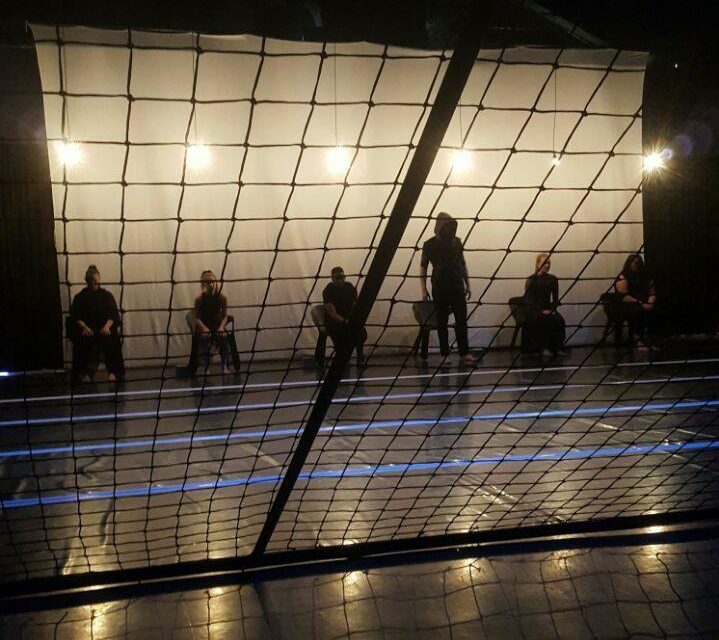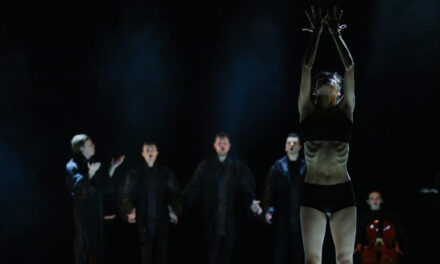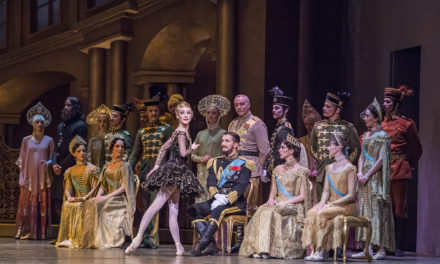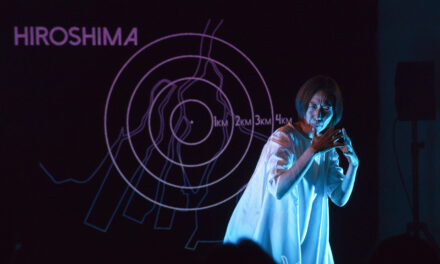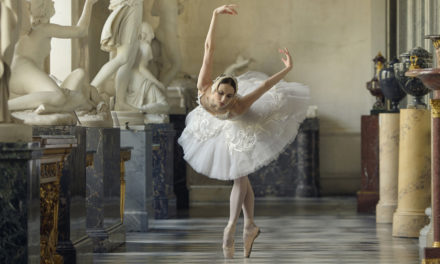Stark white light from bulbs hanging in a straight line against a white backdrop greets audiences in the black theatre space. Stark white lines running parallel with each other cut up the black floor. A line of black chairs runs along the backdrop, emphasizing the linearity and two-dimensionality of the stage design. Between the lines lie possibilities on the brink of enunciation. A black net, strongly angled on the diagonal, covers the space directly in front of the audience from the floor to the catwalk. The interplay of line and dimension that the net offers not only literally distances the audience from the action on stage (invoking the title of the work), but also creates continually shifting perceptions of depth and distance in relation to the movement of the performers and the play of light. The physical theatre performers are dressed in textured black costumes that also subtly play with line and dimension. The stark contrast in color and in the use of light is visually impactful and creates a somber mood. Performers sit still on the chairs, their stillness contrasted with the movement of one performer who carves circular pathways through the stage space – pathways that deliberately contrast the linearity that the stage design set up. As the work progresses and bodies fill the space, the play with line, perspective, perception, contrast, and dimension continues. Frenetic activity interspersed with sustained movement; melancholy interwoven with desperation; linearity commingled with circularity; mortality interrupted by vitality. This is L.I.F.E.

Photo by Westley Smith
In speaking about his latest work, L.I.F.E: a history of distance, award-winning choreographer Bailey Snyman explains that he was experimenting with interpretations of tacit knowledge systems in his creative process. He is particularly interested in excavating and navigating knowledge(s) embodied in people and knowledge(s) embedded in processes. Combining his love of movement with his interest in philosophy towards his doctoral studies, Snyman set up a creative research process that overtly engaged with polymath Michael Polanyi’s beliefs that creative acts are imbued with personal feelings (or passions as per Polanyi). These passions inform the hunches and imaginings in creative processes – they are pre-cognitive processes that comprise of conceptual, perceptual and sensory information that impacts on meaning-making (Smith). This, for Polanyi, is tacit knowledge. Polanyi offers a nuanced and layered understanding of the relationship between science, knowledge, and tacitness. In doing so, he argues that all knowledge is rooted in tacit knowledge and that tacit knowledge is thus part of scientific knowledge. The title of this article is appropriated from Polanyi’s writings in his 1967 book entitled The Tacit Dimension in which he states “I shall reconsider human knowledge by starting from the fact that we can know more than we can tell” (1967:4).
Snyman chose to work with Harald Grimen’s (1991) four interpretations of Polanyi’s ideas on tacit knowledge and to explore whether these interpretations can be ‘translated’ into choreographic strategies that may elucidate tacit knowledge in/of people and processes. He used each of Grimen’s interpretations to create four 20-minute compositions that were presented together as L.I.F.E a history of distance. He summarizes his synthesis of interpretation and narrative as follows:
| Section | Lamentation (L.) | Interruption (I.) | Fate (F.) | Eulogy (E.) |
| Interpretation | Conscious under-articulation:
Tacit knowledge is continuously concealed – to avoid articulating or to under-articulate” in order to elude the danger of ideas/feelings/relationships collapsing because of over-articulation.
|
Gestalt thesis:
The performance of activities is always setup against an un-articulated background, which the ‘doer’ can’t articulate in the process of performance. Knowledge of this background is a mode of tacit knowledge. |
Epistemic regionalism thesis:
Personal knowledge comprises a vast and rhizomatic system that is not easily explained. Smaller parts of this network can be articulated t a time, but not the whole network simultaneously. |
Strong thesis: Specific kinds of knowledge(s) are verbally un-articulatable, indicating that a logical gap between the capacity for cognition, experience and action on the one hand, and the capacity for verbal articulation on the other. This knowledge about unarticulatablity is tacit knowledge.
|
| ‘Transl-tion’ to narrative content | “[W]e are witness to a man who stands and observes his own funeral… fight[ing] against ‘the dying of the light’ and is confronted with the inevitability of his death… [W]e are also privy to the mourning of a mother, a sister, a lover as they negotiate their mortality. The section concludes with a final rush against mortality as the performers confront each other in, through and with each other”.
|
“[I.] explores the moment of paralysis within the body when rigor mortis sets in. The narrative unfolds as a desperate evocation of attempting to free the resistant bodies from their static states. The narrative further unfolds as an attempt to resist death through breathing life back into the body through sensitisation and mobilization”.
|
“[F.] evokes the sense of journey for the lead male character. He is led on various pathways within his body, as well as, spatial journeys by the other performers. Here his resistance to death is marked as an internal (bodily) and external (spatial) journey”.
|
“[E.] becomes a moment of acceptance and letting go. The man is encouraged to accept his mortality and through the ritual of repetition of the final breath gestures he is set free from the confines and angst of his life”. |

Photo by Westley Smith
For Snyman, dance and physical theatre are able to convey abstract, symbolic, intangible and nonverbal ideas and an ideal vehicle for his explorations. In order to “translate” the interpretations into choreographic strategies, he selected an overarching strategy that resonates with Polanyi’s central theorem for all four works. He requested that performers journal their personal responses to the choreographic tasks he set and keep the information from others and from him. As the choreographer, he chose not to share his thematic vision for the work with the performers but hoped that thematic content will emerge through the choreographic tasks set, movement metaphors, inner sensing, sympathetic resonance and the performers’ bodily interpretations of the tasks. The articulation of rhizomes of knowledge(s) happened in the interplay between body, space, time and dynamics. He activated specific ideas drawn from the interpretations to “translate” into choreographic strategies. For example, he states that he drew on Sabar’s (2012) in working with Gestalt Therapy’s foci on embodiment and identification of the locations of resistances to the free-flow and expression of movement and energy in the body; and how conflict is held in bodies to create the section on Interruptions. In trying to use conflict and holding patterns in the performer’s bodies for choreographic purposes, he said that he removed free flow in movement and organic transferences of weight/transitions in partnering work:
“[T]he dancers were tasked with creating a series of duets and trios through the idea of one or more partners remaining ‘frozen’ and unearthing the possibilities of creating an embodied partnering moment through the seemingly dis-embodied task. …[E]ach performer [received] a geometric shape to work with as a floor pattern: a line, a circle, a square, a triangle in order to uncover their seemingly disparate relation to each other in order to create various proximities through similarity to generate visual closure…”
For Eulogy, he explains, he focused on knowledge(s) to do with sensory, proprioceptive and visceral qualities, and the arrangement of actions. As these are challenging to articulate he chose to make use of structured improvisation: for example, tasking performers with developing and presenting a gesture that figuratively expressed their last breath. The gestures were then used as a basis for a gestural routine that was developed into a sequence merging posture and gesture that furthered the narrative and was stylised through repetition and unison.

Photo by Westley Smith
The narrative content of the sections created around each of the interpretations was supported by the stage and spatial design (including the performers’ bodies creating patterns in space and time – floor and air patterns), and the music and movement vocabulary selected. The performer’s qualitative interpretation of the movement material created dynamic variation and layered expressive nuances that kindled metakinesis, kinesthetic empathy and emotive responses in many an audience member. Whilst he can give his choices of music, creative use of scenic elements (such as the chairs and the net in front of the audience) and the ‘editing’ of the work more consideration, the result of Snyman’s explorations was an aesthetically coherent and deeply moving work. The kinesthetic empathy the work evoked brought into sharp focus that the act of viewing is both visual and physical, like the dancers, the audience is embodied in their experience of the work. In a way, between the performers and audience, a co-articulation of the un-articulatable took shape.
More than an experiment with compositional strategies, Snyman’s work demonstrates a dramaturgical consciousness, which acknowledges the body and the un-articulatable as its centripetal agents. The ways in which he ‘translates’ ideas into compositional drivers for physical theatre may open up spaces of enunciation for theatre-makers and choreographers alike.
Sources consulted
Polanyi, M. The Tacit Dimension. 1967. New York: Anchor Books.
Smith, M. K. 2003. ‘Michael Polanyi and tacit knowledge’. The encyclopedia of informal education. http://infed.org/mobi/michael-polanyi-and-tacit-knowledge/
Snyman, B. 2017. L.I.F.E a history of distance. [Physical Theatre Production and framing document].
This post was written by the author in their personal capacity.The opinions expressed in this article are the author’s own and do not reflect the view of The Theatre Times, their staff or collaborators.
This post was written by Marié-Heleen Coetzee.
The views expressed here belong to the author and do not necessarily reflect our views and opinions.

